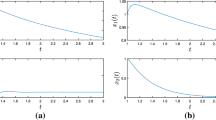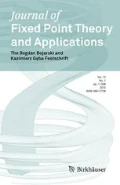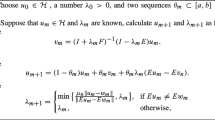Abstract
The Douglas–Rachford splitting method is a classical and powerful method that is widely used in engineering fields for finding a zero of the sum of two operators. In this paper, we begin by proposing an abstract second-order dynamic system involving a generalized cocoercive operator to find a zero of the operator in a real Hilbert space. Then we develop a second-order adaptive Douglas–Rachford dynamic system for finding a zero of the sum of two operators, one of which is strongly monotone while the other one is weakly monotone. With proper tuning of the parameters such that the adaptive Douglas–Rachford operator is quasi-nonexpansive, we demonstrate that the trajectory of the proposed adaptive system converges weakly to a fixed point of the adaptive operator. When the strong monotonicity strictly outweighs the weak one, we further derive the strong convergence of shadow trajectories to the solution of the original problem. Finally, two simulation examples are reported to corroborate the effectiveness of the proposed adaptive system.









Similar content being viewed by others

Notes
This notion has appeared in [21, Proposition 1 (iii)].
References
Abbas, B., Attouch, H., Svaiter, B.F.: Newton-like dynamics and forward-backward methods for structured monotone inclusions in Hilbert spaces. J. Optim. Theory Appl. 161, 331–360 (2014)
Alvarez, F.: On the minimizing property of a second order dissipative system in Hilbert spaces. SIAM J. Control Optim. 38(4), 1102–1119 (2002)
Antipin, A.S.: Minimization of convex functions on convex sets by means of differential equations. Differ. Equ. 30(9), 1365–1375 (1994)
Attouch, H., Alvarez, F.: The heavy ball with friction dynamical system for convex constrained minimization problems. Optimization, pp. 25–35. Springer, Heidelberg (2000)
Attouch, H., Boţ, R.I., Csetnek, E.R.: Fast optimization via inertial dynamics with closed-loop damping. J. Eur. Math. Soc. (to appear)
Attouch, H., Chbani, Z., Peypouquet, J., Redont, P.: Fast convergence of inertial dynamics and algorithms with asymptotic vanishing viscosity. Math. Program. 168(1–2), 123–175 (2018)
Attouch, H., Cabot, A., Redont, P.: The dynamics of elastic shocks via epigraphical regularization of a differential inclusion. Barrier and penalty approximations. Adv. Math. Sci. Appl. 12(1), 273–306 (2002)
Attouch, H., Chbani, Z., Riahi, H.: Fast proximal methods via time scaling of damped inertial dynamics. SIAM J. Optim. 29(3), 2227–2256 (2019)
Attouch, H., Chbani, Z., Riahi, H.: Rate of convergence of the Nesterov accelerated gradient method in the subcritical case \(\alpha \le 3\). ESAIM: Control Optim. Calc. Var. 25 (2019)
Attouch, H., Goudou, X., Redont, P.: The heavy ball with friction method, I. The continuous dynamical system: global exploration of the local minima of a real-valued function by asymptotic analysis of a dissipative dynamical system. Commun. Contemp. Math. 2(01), 1–34 (2000)
Attouch, H., Svaiter, B.F.: A continuous dynamical Newton-like approach to solving monotone inclusions. SIAM J. Control Optim. 49, 574–598 (2011)
Bauschke, H.H., Combettes, P.L.: Convex Analysis and Monotone Operator Theory in Hilbert Spaces. Springer, Cham (2017)
Bayram, I., Selesnick, I.W.: The Douglas–Rachford algorithm for weakly convex penalties. arXiv:1511.03920v1 (2015)
Beck, A., Teboulle, M.: A fast iterative shrinkage-thresholding algorithm for linear inverse problems. SIAM J. Imaging Sci. 2(1), 183–202 (2009)
Bogdan, M., Berg, E.V.D., Su, W., Candes, E.: Statistical estimation and testing via the sorted L1 norm. arXiv preprint. arXiv:1310.1969 (2013)
Borwein, J.M.: Fifty years of maximal monotonicity. Optim. Lett. 4(4), 473–490 (2010)
Boţ, R.I., Csetnek, E.R.: A dynamical system associated with the fixed points set of a nonexpansive operator. J. Dyn. Differ. Equ. 29(1), 155–168 (2017)
Boţ, R.I., Csetnek, E.R., Hendrich, C.: Inertial Douglas–Rachford splitting for monotone inclusion problems. Appl. Math. Comput. 256, 472–487 (2015)
Boţ, R.I., Csetnek, E.R.: Second order forward-backward dynamical systems for monotone inclusion problems. SIAM J. Control Optim. 54(3), 1423–1443 (2016)
Boţ, R.I., Hendrich, C.: A Douglas–Rachford type primal-dual method for solving inclusions with mixtures of composite and parallel-sum type monotone operators. SIAM J. Optim. 23(4), 2541–2565 (2013)
Boţ, R.I., Sedlmayer M., Vuong P. T. A relaxed inertial forward-backward-forward algorithm for solving monotone inclusions with application to GANs. arXiv preprint. arXiv:2003.07886 (2020)
Briceño-Arias, L.M., Combettes, P.L.: A monotone+skew splitting model for composite monotone inclusions in duality. SIAM J. Optim. 21(4), 1230–1250 (2011)
Briceño-Arias, L.M.: Forward–Douglas–Rachford splitting and forward-partial inverse method for solving monotone inclusions. Optimization 64(5), 1239–1261 (2015)
Bruckstein, A.M., Donoho, D.L., Elad, M.: From sparse solutions of systems of equations to sparse modeling of signals and images. SIAM Rev. 51, 34–81 (2015)
Chambolle, A., Pock, T.: A first-order primal-dual algorithm for convex problems with applications to imaging. J. Math. Imaging Vis. 40(1), 120–145 (2011)
Combettes, P.L.: Systems of structured monotone inclusions: duality, algorithms, and applications. SIAM J. Optim. 23(4), 2420–2447 (2013)
Csetnek, E.R.: Continuous dynamics related to monotone inclusions and non-smooth optimization problems. Set-Valued Var. Anal. 28(4), 611–642 (2020)
Csetnek, E.R., Malitsky, Y., Tam, M.K.: Shadow Douglas–Rachford splitting for monotone inclusions. Appl. Math. Optim. 80(3), 665–678 (2019)
Dao, M.N., Phan, H.M.: Adaptive Douglas–Rachford splitting algorithm for the sum of two operators. SIAM J. Optim. 29(4), 2697–2724 (2019)
Dao, M.N., Phan, H.M.: Linear convergence of the generalized Douglas–Rachford algorithm for feasibility problems. J. Glob. Optim. 72(3), 443–474 (2018)
Davis, D., Yin, W.: A three-operator splitting scheme and its optimization applications. Set-Valued Var. Anal. 25(4), 829–858 (2017)
Douglas, J., Rachford, H.H.: On the numerical solution of heat conduction problems in two or three space variables. Trans. Am. Math. Soc. 82, 421–439 (1956)
Eckstein, J., Bertsekas, D.P.: On the Douglas–Rachford splitting method and the proximal point algorithm for maximal monotone operators. Math. Program. 55, 293–318 (1992)
Fan, J.Q., Li, R.Z.: Variable selection via nonconcave penalized likelihood and its oracle properties. J. Am. Stat. Assoc. 96, 1348–1360 (2015)
Gabay, D.: Applications of the method of multipliers to variational inequalities. In: Fortin, M., Glowinski, R. (eds.) Augmented Lagrangian Methods: Applications to the Solution of Boundary-Value Problems. North Holland, Amsterdam (1983)
Guo, K., Han, D.R.: A note on the Douglas–Rachford splitting method for optimization problems involving hypoconvex functions. J. Glob. Optim. 72(3), 431–441 (2018)
Guo, K., Han, D.R., Yuan, X.M.: Convergence analysis of Douglas–Rachford splitting method for “Strongly+Weakly” convex programming. SIAM J. Numer. Anal. 55, 1549–1577 (2017)
Haraux, A., Jendoubi, M.A.: The Convergence Problem for Dissipative Autonomous Systems: Classical Methods and Recent Advances. Springer, Berlin (2015)
He, B.S., Yuan, X.M.: On the convergence rate of the Douglas–Rachford operator splitting method. Math. Program. 153, 715–722 (2015)
Lawrence, J., Spingarn, J.E.: On fixed points of nonexpansive piecewise isometric mappings. Proc. Lond. Math. Soc. 3(3), 605–624 (1987)
Lindstrom, S.B., Sims, B.: Survey: Sixty Years of Douglas–Rachford. arXiv:1809.07181 (2018)
Lions, P.L., Mercier, B.: Splitting algorithms for the sum of two nonlinear operators. SIAM J. Numer. Anal. 16, 964–979 (1979)
Mordukhovich, B.S.: Variational Analysis and Generalized Differentiation I: Basic Theory. Springer Science-Business Media, New York (2006)
Nesterov, Y.: A method of solving a convex programming problem with convergence rate \(O(\frac{1}{k^ 2})\). Sov. Math. Dokl. 27, 372–376 (1983)
Nesterov, Y.: Introductory Lectures on Convex Optimization: A basic course of Applied Optimization, vol. 87. Kluwer Academic Publishers, Boston (2004)
Polyak, B.T.: Introduction to Optimization. Optimization Software, New York (1987)
Rockafellar, R.T., Wets, R.J.B.: Variational Analysis. Springer Science and Business Media, New York (2009)
Su, W., Boyd, S., Candès, E.J.: A differential equation for modeling Nesterov’s accelerated gradient method: theory and insights. Neural. Inf. Process. Syst. 27, 2510–2518 (2014)
Svaiter, B.F.: On weak convergence of the Douglas–Rachford method. SIAM J. Control Optim. 49(1), 280–287 (2011)
Tibshirani, R.: Regression shrinkage and selection via the lasso. J. R. Stat. Soc. B. 58, 267–288 (1996)
Vial, J.P.: Strong and weak convexity of sets and functions. Math. Oper. Res. 8(2), 231–259 (1983)
Vũ, B.C.: A splitting algorithm for dual monotone inclusions involving cocoercive operators. Adv. Comput. Math. 38(3), 667–681 (2013)
Yan, M.: A new primal-dual algorithm for minimizing the sum of three functions with a linear operator. J. Sci. Comput. 76(3), 1698–1717 (2018)
Zhu, M., Hu, R., Fang, Y.: A continuous dynamical splitting method for solving ’strongly+weakly’ convex programming problems. Optimization 69(6), 1335–1359 (2020)
Zhu, M., Hu, R., Fang, Y.: Asymptotic behavior of a nonautonomous evolution equation governed by a quasi-nonexpansive operator. Preprint (2020). arXiv: 2001.04628 (2020)
Acknowledgements
The authors would like to thank the anonymous referees and the editor for their helpful comments and suggestions which have led to the improvement of the early version of this paper.
Author information
Authors and Affiliations
Corresponding author
Additional information
Publisher's Note
Springer Nature remains neutral with regard to jurisdictional claims in published maps and institutional affiliations.
This work was partially supported by the National Natural Science Foundation of China (11471230).
Rights and permissions
About this article
Cite this article
Zhu, M., Hu, R. & Fang, YP. A second-order adaptive Douglas–Rachford dynamic method for maximal \(\alpha \)-monotone operators. J. Fixed Point Theory Appl. 23, 25 (2021). https://doi.org/10.1007/s11784-021-00862-4
Accepted:
Published:
DOI: https://doi.org/10.1007/s11784-021-00862-4
Keywords
- Adaptive Douglas–Rachford algorithm
- second-order dynamic system
- maximal \(\alpha \)-monotone operator
- quasi-nonexpansive operator



